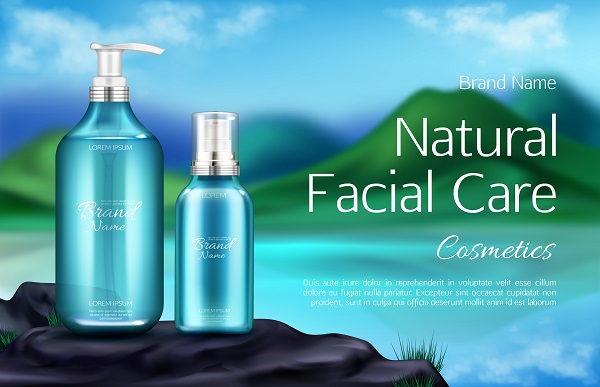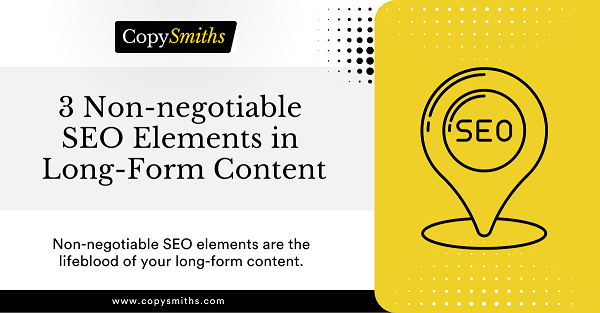Did you know that over 200 Google factors determine how well your content ranks in search engines? But which must-have factors should you incorporate into your long-form content to drive positive SEO results?
That’s what we’ll unveil for you today.
Non-negotiable SEO elements are the lifeblood of your long-form content—they’re not up for discussion.
The same way you can’t negotiate eating food for your health, you can’t think twice about adding these elements to your long-form content.
Today, we’ll walk you through our three vital elements to liven your content and keep everyone happy—you, your readers, and the search engines. When done well, they’ll help you:
- Gain credibility
- Attract organic traffic
- Build rapport with your readers
- Optimize your long-form content
“Anything you do that improves the user experience and happiness of people who are looking at your page helps you long term in Google.” – Rand Fishkin, CEO & Co-Founder Moz
Element 1- Useful, High-quality Images

Topping our list of non-negotiable SEO elements in long-form content are useful, high-quality images.
Picture This: You have a 4000-word article with zero images, just one block of text after another. Do you think it’ll keep readers engaged from start to finish? No.
Here are three reasons why images are a must-have in your long-form content:
- HubSpot’s Marketing Manager attests that images significantly increased their content’s impressions and click-through rates
- According to Facebook, companies’ status updates containing photos and videos produce up to 180% engagement
- Jeff Bullas confirms that content with images gets viewed 90% more than content without images
Admittedly, photos are necessary for long-form content because they hook your readers, given that lengthy information lowers our attention span. Therefore, when incorporated throughout your long-form content, they will increase user dwell time.
Examples of valuable and high-quality visuals include size charts, videos, tables, bullet lists, and pictures. They help break down large blocks of written text into a quick-to-grasp content overview.
In the following table, we compare three types of images and how they compare:
| Visual | Description | Purpose |
| Table | Uses rows and columns to showcase information and data | Compares numbers, values, and ideas |
| Graph | Visual illustration of numerical information | Visually demonstrates various relationships within your data |
| Chart | Graphical representation of data in symbols | Showcases large quantities of data in a digestible way |
Importance of Using Images in Long-form Content
Here are two reasons why adding images to your long-form content should not be up for discussion:
Increase Your Credibility
Readers and Google love content that shows authenticity. Including visual elements, such as testimonials, shows your legitimacy and makes your readers understand your product better through the evidence of users’ opinions.
Since testimonials are unbiased reviews of your customers’ experience, results, and satisfaction with your product, readers are more likely to trust them than your own marketing. And when they trust your reviews, they’ll ultimately build trust and rapport with you.
Boost Your SEO Rankings
Images boost your SEO rankings, especially when paired with additional texts like title tags, captions, source, and alt text. Optimizing these texts on your images attracts organic traffic to your site, which helps welcome potential leads.
High-quality, crystal-clear images that don’t take up much space will also help your content load faster. As such, they’re great for user experience, which in turn will boost SEO rankings.
Element 2 – Appropriate Internal and External Links
Links are a non-negotiable SEO element when it comes to posts because they’re crucial to a website’s architecture.
Here’s what we mean: Through links, your content is connected to other documents on the web, making it easy for readers to move from one page to another.
Without links, readers and search engines wouldn’t know how to access your content. When applied well, they’ll enhance your page’s credibility and quality. Let’s take a closer look at them:
Internal Links
“Internal linking helps us to find pages and get a bit of context about that specific page.” – John Mueller, Google Webmaster Trends Analyst
Through internal links, Google understands the pages on your site while assisting readers in navigating your long-form content.
The more readers dwell on your site, the more they’ll familiarize themselves with your brand, thus solidifying their trust in your product or service. In turn, they’ll engage with your content which can ultimately lead to conversions.
How to Effectively Use Internal Links
- According to Google’s SEO Starter Guide, anchor text should contain keywords that are relevant to your topic or what you want to rank for
- The first links in your content should be from your website. When you link to an external website, readers are likely to follow the link and leave your site
- There isn’t a particular number of links to use in long-form content. An ideal number, however, is 2–5 for a 1500-word post
- Don’t use the same anchor text across articles. Google will conclude that you’re creating duplicate content and rank you lower in search engine results
External Links
External links are powerful, must-have SEO elements when it comes to long-form content. Through them, readers are directed to relevant information, and search engines can understand what you’re talking about.
Did you know that you gain credibility when you link to trustworthy sources, such as peer-reviewed papers and government sources? Authoritative external links force readers to see that your content is highly factual and has undergone extensive research.
And since high-quality pages link to fellow high-quality pages, search engines will gain trust in your content and help your site rank higher in search engine results pages (SERPS).
Also, when readers learn more about your content, it’ll enhance your user experience ratings (the backbone of a site’s navigation), which is perfect for SEO.
How to Effectively Use External Links
- Link to high authority and trustworthy pages. Avoid linking to generalists, and instead choose academic papers or experts in the industry. By doing so, you’re informing Google that your site is an authoritative source of information about what you’re writing on
- Links should be contextual. If you link to a random website that’s not relevant to what you’re writing about, it’ll seem like spam to your readers and hurt your SEO efforts
- Allow the external link to open in a new tab so users can easily return to your site
- Include appropriate anchor text. For example:
- Learn more about SEO elements in long-form content.
- Learn more about SEO elements in long-form content.
The second example features the anchor text that’ll help Google and readers understand the page’s content better.
Element 3 – Using Credible Social Proof
Lastly, your content needs credible social proof.
Credible social proof is non-negotiable because it’s one way to prove to your readers that your eCommerce store is legitimate. Indeed, social proof adds that human element readers need to see before doing business with you.
Credible social proof, such as customer reviews, quotes, testimonials, and short videos, not only boosts the credibility of your business, they also attract customers to your brand.
Customer Reviews and Testimonials
Customer reviews and testimonials are one of the most dependable forms of social proof.
Did you know that happy customers are your biggest advocates? They help potential customers make informed buying decisions through their reviews and testimonials.
This evidence justifies why you should include customer reviews in your long-form content:
- Google ranks local businesses based on a 15% higher customer review
- Online reviews influence how consumers buy services or products. That’s why for every star rise on Yelp, companies gain more revenue
Expert Tip: When you include testimonials in your content, ensure you highlight their authenticity by providing the customer’s full name and website so readers gain more trust in your site.
Take a look at our customer review below:

Spice up Your Long-Form Content With Us
Now you know which non-negotiable elements to use in your long-form content. Compelling images, credible social proof, and internal and external links are the keys to making your long-form content rise through SERPs.
To drive quick results, get the help of a content strategist who’ll help you add these and more hacks to your content.
At CopySmiths, we have SEO’s best practices at our fingertips. As such, we can help you craft valuable content.
Share on LinkedIn:

